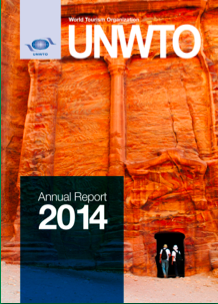
16 Jun, 2015
Global Travel & Tourism now an “Unstoppable Force” – UNWTO chief
Madrid, 16 June 2015 — The global travel & tourism industry is now an “unstoppable force”, generating not just visitor numbers and economic growth but also representing “an effective solution for many of the world’s greatest challenges,” says UN World Tourism Organisation Secretary-General Taleb Rifai in the newly-released UNWTO Annual Report for 2014.
The 88-page report provides an exhaustive roster of the dozens of activities and events undertaken by the UNWTO to fulfill its seven-point agenda: Mainstreaming tourism in the global agenda; Improving tourism competitiveness; Promoting sustainable tourism development; Advancing tourism’s contribution to poverty reduction and development; Fostering knowledge, education and capacity-building; Building partnerships for tourism; and executing Regional programmes in support of Member States.
It also acts as an important template and checklist for international tourism organisations and associations seeking to provide more effective, relevant services to an increasingly demanding membership.
Says Mr Rifai in his introduction, “The top headlines of 2014 painted a challenging landscape. From sluggish economic growth and geopolitical conflicts to the Ebola virus outbreak in West Africa – to all appearances, such circumstances were hardly favorable for tourism.
“Yet in spite of the many challenges the world faced in 2014, international tourism continued to propel ahead. At the year’s close, the number of tourists travelling internationally grew by 4.4%, reaching a new milestone of 1,135 million and capping a five-year consecutive increase since the global economic crisis of 2009. Once again, these results have surpassed UNWTO’s long- term projection of 3.8% growth for the period 2010 to 2020, well on track to reach the projected 1.8 billion international tourists by the year 2030.”
He adds, “With over 1.1 billion tourists taking an international trip every year, tourism continues to be an unstoppable force and a key driver of the global economic recovery. Yet tourism ́s record growth is not merely absolute numbers. Tourism’s continued progress and expansion represents an effective solution for many of the world’s greatest challenges. Indeed, few sectors are as strategically positioned as tourism to contribute decisively to job creation, poverty alleviation, environmental protection and multicultural peace and understanding.”
Dr Rifai notes that “tourism’s increasing relevance on the development agenda comes at a critical turning point as we shift from the Millennium Development Goals (MDGs) into the Sustainable Development Goals (SDGs), the new blueprint for global development. During this crucial time, as an important player in achieving the ambitious goals of sustainable development, green growth and a more resilient global economy.
“Global challenges call for global solutions. Our commitment remains in advancing UNWTO’s mandate to promote tourism as a driver of economic growth, inclusive development and environmental sustainability and a global solution for a better future for the planet and its people.”
The report notes that International tourism capped off 2014 with record numbers, growing 4.4% to reach 1,135 million tourists that crossed international borders during the year. Receipts from international tourism increased 3.7% in real terms, reaching an estimated US$ 1,245 billion (euro 937 billion) in 2014.
Adding up the export earnings generated through international passenger transport services (US$ 221 billion in 2014), total exports from international tourism were up to US$ 1.5 trillion, or US$ 4 billion a day on average in 2014.
For 2015, UNWTO forecasts international tourism to grow by 3% to 4%, contributing further to the global economic revival. By region, growth is expected to be strongest in Asia (+4% to 5%) and followed by Europe (+3% to +4%), Africa (+3% to +5) and the Middle East (+2% to +5%).




Liked this article? Share it!